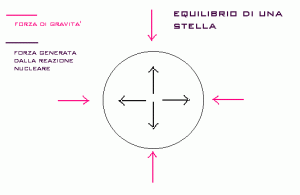
Life of stars like Sun is about 10 billion years. During the evolution, stars are steady because there are two forces: gravity attraction and nuclear fusion pressure. Gravity attraction compress the star and nuclear fusion pressure push the gas out.

This balance is very important!
Star is like thermostat because if gravity grow up, for a decreasing of nuclear temperature, then star contract itself and less volume causes raising temperature and then so nuclear pressure raises up. Balance is established. In the other case, when nuclear fusion pressure raise up there is a raising mass star and then a raising gravity attraction because mass is related with gravity attraction.
This
"thermostat" works until star blows hydrogen. After,
when hydrogen ends, star becames a change.

Gravity attraction and nuclear fusion pressure work as "thermostat".
Fisic structure

Stars are like an onion. There are several
layers rounds them. In the center there is a part called "Core"
and it is nucleus of stars. In this zone temperature is about 15.000.000
°C (in a Sun like star) and hydrogen change into elium by the
nuclear fusion process. Light spends thounsands of years to came
from the nucleus to our eyes because inside layers are dull to
light energy.
Stars give out energy on the entire spectrum.
Infact stars give out visible light, X ray, infrared ray, gamma
ray and radio waves. Arond the stars, moreover, occurs many
magnetic storms and Sun is an example because with its magnetic
storms breakes down our satellites in orbit around the earth.
From the stars' nucleus give out "neutrins" particles
that have a very small mass and they have produced in the nuclear
fusion process.
When hydrogen runs out then start a new moment for the star.